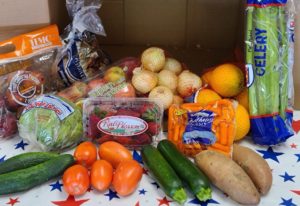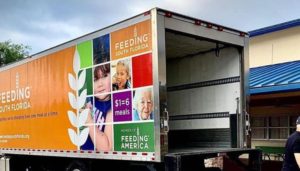Food banks may have gotten an extra $450 million for emergency food in the federal coronavirus aid package passed last week, but it’s not nearly enough. Feeding America says its network of member food banks will need $1.4 billion in additional resources over the next six months, representing a 30% increase in their six-month operating costs.
A sharp rise in unemployment for people already at risk of hunger is expected to catapult the number of people experiencing food-insecurity by about 17 million, a 46% increase from the current 37 million, says Feeding America. That demand is complicated by supply-side challenges, including fewer donations from food manufacturers and grocers as they struggle to keep shelves filled, as well as a precipitous drop in the number of volunteer helpers. Feeding America estimates the volunteer workforce has dropped by 60% across its network in a matter of weeks.
The confluence of challenges amounts to “a perfect storm,” said Claire Babineaux-Fontenot, CEO of Feeding America.
The signs that food banks are under incredible strain as they struggle to meet demand are everywhere: in the mile-long line of cars waiting to receive food from Greater Pittsburgh Community Food Bank earlier this week; at Atlanta Community Food Bank, which reports spending more than $500,000 over seven days to purchase food, versus less than $50,000 typically; at Midwest Food Bank in Illinois, which saw its normal five- to six-week supply of warehoused food steady at a 3.6-week supply by early April, and at Greater Boston Food Bank, which distributed 8.1 million pounds of food in March 2020, compared to 5.5 million in March 2019.
In fact, Feeding America’s $1.4 billion estimate may not reflect the full scope of need since there are at least an additional 50 food banks, large and small, that operate outside the scope of the Feeding America network. The network also does not take into account the dozens of local food-rescue organizations nationwide that aid the food-insecure, and are also expected to face challenges in getting food donations.
While the need for resources to support food banks is undeniable, the most effective salve to address the nation’s growing food insecurity comes in the form of direct federal assistance. SNAP, which is designed to expand with need, is sure to spike from its current allocation of $60 billion. Its last peak of $80 billion came in 2013 when the economy still reflected the lingering impact of the recession.
“The long-term message is that food banks fill in the gap, but they cannot be the long-term solution,” said Joel Berg, CEO of Hunger Free America, speaking this week at a Hunter College NYC Food Policy Center forum.
SNAP, by far the largest of the federal assistance programs, provides at least ten times the amount of food as food banks, Berg said. Plus, it takes advantage of a ready-made distribution network in the form of the nation’s retail grocers. The pandemic meanwhile has underscored flaws in the food banks’ outsized reliance on food pantries and their elderly volunteers to distribute food. Three Square Food Bank in Las Vegas is among the many that have moved aggressively to reorganize their pantry networks to protect senior workers.
In New York City, “there are 8,000 retail establishments that accept SNAP, and they’re far more likely to be open than food pantries,” Berg said. While aid to food banks is necessary, Hunger Free America is really pushing for more money to help people access benefits. Federal benefits are “by far the most effective way to get the most food to the most people most quickly,” Berg said.









